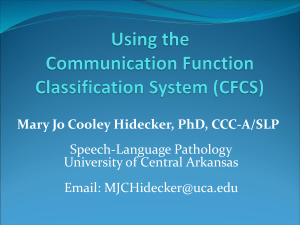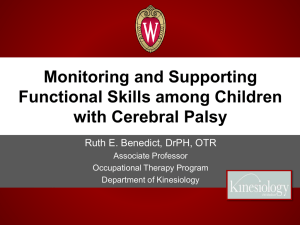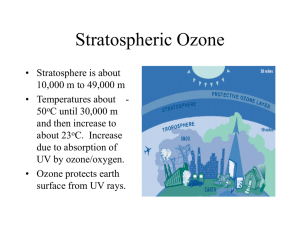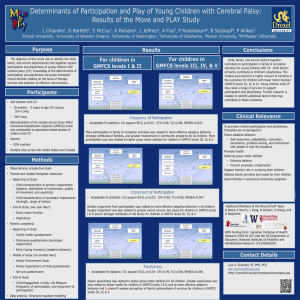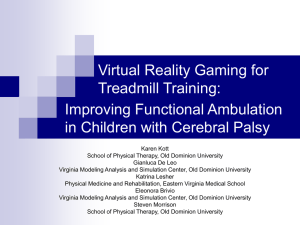Taylor_Poole_2010_09_30
advertisement
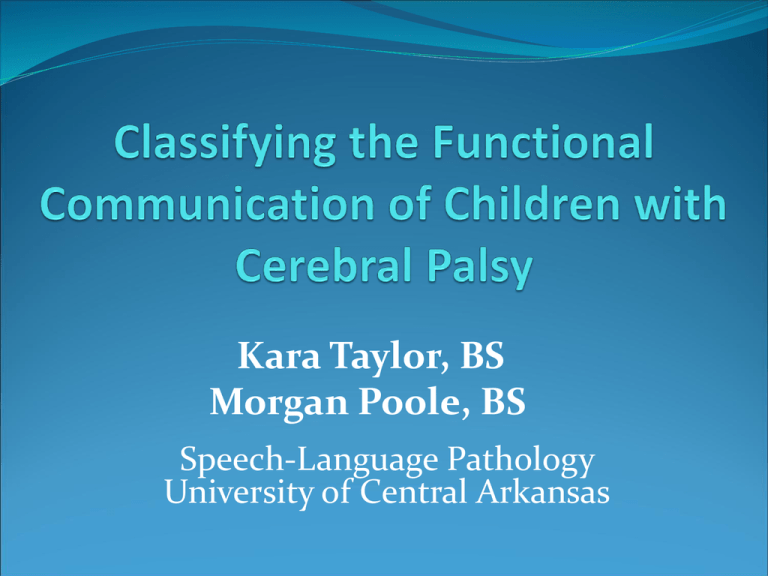
Kara Taylor, BS Morgan Poole, BS Speech-Language Pathology University of Central Arkansas Cerebral Palsy Definition “describes a group of permanent disorders of the development of movement and posture, causing activity limitations, that are attributed to nonprogressive disturbances that occurred in the developing fetal or infant brain. The motor disturbances of cerebral palsy are often accompanied by disturbances of sensation, perception, cognition, communication, and behaviour, by epilepsy, and by secondary musculoskeletal problems” Rosenbaum, et al. (2007) Functional Limitations in Daily Activities Mobility Palisano et al., 1997 Gross Motor Function Classification System (GMFCS) www.canchild.ca/Portals/0/outcomes/pdf/GMFCS-ER.pdf Handling Objects Eliasson et al., 2006 Manual Ability Classification System (MACS) for children with cerebral palsy 4-18 years www.macs.nu/ Communication Hidecker et al., under development Communication Function Classification System (CFCS) www.cfcs.us/ Eating/Drooling Sellers et al., under development Manchester U.K. Comparison of Classification Tools GMFCS Mobility MACS Handling objects CFCS Level Communicating Effective sender/receiver Walks without Handles objects easily I. with unfamiliar and limitations. and successfully. familiar partners Handles most objects Effective but slower Walks with but with somewhat sender/receiver with II. limitations. reduced quality and/or unfamiliar and familiar spread of achievement. partners Handles objects with Walks using difficulty; needs help Effective sender/receiver III. a hand-held to prepare and/or with familiar partners mobility device. modify activities. Self-mobility Handles a limited with limitations; Inconsistent sender selection of easily IV. May use and/or receiver with managed objects in powered familiar partners adapted situations. mobility. Does not handle objects Transported in Seldom effective and has severely limited V. a manual sender/receiver even ability to perform even wheelchair. with familiar partners simple actions. Few Communication Measures in CP Studies Need: Better measures of speech, language, and hearing within existing CP epidemiological studies. Challenge: Quick, multidisciplinary measure of communication Hope: More SLPs and audiologists will be included on CP research teams Cooley Hidecker et al., 2009 Cooley Hidecker et al., 2009 Cooley Hidecker et al., 2009 Current CFCS Draft Cooley Hidecker et al., 2009 CFCS Level Identification Chart Hidecker et al. Please do not use without permission Objectives To analyze the communication of a sample of children with CP by: Communication modes GMFCS (mobility classification) MACS (hand use classification) Cerebral palsy types Comorbidities Participants 71 children with CP Ages 2 to 18 years Parent raters If no parent rating, used professional rating Communication Methods 41 of 71 used speech 15 of 41 used ONLY speech 56 of 71 were multi-modal Speech (n=26) Sounds (n=51) Eye gaze, facial expressions, gesturing, &/or pointing (n=53) Manual signs (n=20) Communication books, boards, and/or pictures (n=19) Speech-generating devices or voice output devices (n=16) CFCS & Communication Modes Speech Speech, No No Speech & unaided speech unaided CFCS Speech Unaided AAC & unaided AAC & AAC aided AAC AAC aided AAC Level Only I II III IV V 7 5 2 1 0 1 6 4 3 0 1 4 4 3 0 0 2 2 4 8 0 1 1 9 3 SGD/VOCA by CFCS Level Speech-generating devices or voice output devices (n=16) CFCS Level I (n=1) CFCS Level II (n=2) CFCS Level III (n=3) CFCS Level IV (n=8) CFCS Level V (n=2) GMFCS & MACS Levels by CFCS Level CFCS Level I MACS GMFCS I I 2 II 3 II III IV V Total 2 2 5 III 0 IV 0 V Total 1 5 3 1 0 1 2 0 9 GMFCS & MACS Levels by CFCS Level CFCS Level II GMFCS MACS I II I 1 3 II 1 3 III IV V 1 5 1 2 V 1 2 8 Total 4 1 IV Total III 3 2 1 2 4 1 2 16 GMFCS & MACS Levels by CFCS Level GMFCS I I II III IV V Total 1 1 CFCS Level III MACS II III IV 1 1 3 1 1 1 2 1 5 4 2 V 0 Total 1 1 5 1 4 12 GMFCS & MACS Levels by CFCS Level GMFCS I I II III IV V Total 1 1 CFCS Level IV MACS II III IV 4 1 2 1 7 1 3 4 7 V 1 2 3 Total 0 5 1 7 6 19 GMFCS & MACS Levels by CFCS Level GMFCS I I II III IV V Total 0 CFCS Level V MACS II III IV V 0 1 1 2 4 7 7 0 Total 0 0 1 1 9 11 Types of Cerebral Palsy and CFCS Types of CP Bilateral (n= 63) Hemiplegia (n= 13) Spastic (n= 62) Dyskinetic (n= 5) Dystonic (n= 27) Choreo-athetotic (n= 4) Ataxic (n= 10) CP type NOT a predictor of CFCS Level Comorbidities and CFCS Levels • developmental delay (85%) • mild or severe cognitive impairment (56%) • seizure disorder (52%) • language disorder (45%) • visual impairment not corrected by glasses (44%) • dysarthria (34%) • apraxia of speech (27 %) Key Findings CFCS with GMFCS and MACS provides a more complete view of the functional abilities of children with CP. Speech was associated with more effective communicators. Clinical Implications Accessible, common tool that can be used by both parents and professionals. Useful when talking with families and other professionals. Support understanding among various members of multidisciplinary teams. Current research directions Measure the CFCS stability across the life span. Need research partners who serve individuals with CP from age 2 to 21 Will classify CFCS and collect additional data over the course of 4 years Current research directions CFCS to cerebral palsy registries’ data? Surveillance of CP in Europe (SCPE) Translate/validate CFCS in languages Currently underway Arabic Dutch Turkish Need Spanish partners • Translation Interests • ????? Clinical Implications – examples Knowing a person’s CFCS classification may suggest a starting point for intervention (we still need clinical research evidence) Level I – Any activity or participation limitations? Decrease any residual speech sound errors? Level II – Any ways to speed up communication, especially with unfamiliar partners? Can repair strategies be improved? Can AAC access/composing methods be faster? Clinical Implications – examples Level III – Increase communication partners? Improve communication repair strategies? Add AAC? Level IV – Increase sender and/or receiver skills? Add AAC? Level V – Improve partner recognition of gestures and unconventional messages? Focus on communication partner training. Create a communication dictionary of these unconventional message. Pair AAC message with unconventional message. Future research directions Create a snapshot of a person’s functional levels by reporting the CFCS in conjunction with GMFCS & MACS. Correlate the CFCS level to quality of life and/or participation measures. Future research directions Validate the CFCS in other populations including those with autism, Down syndrome, and post-stroke. Study the possible effect of additional AAC components and operational competencies on CFCS Levels. Acknowledgements Thank you to the individuals who participated: In addition to those who chose to contribute anonymously, Development Team: Sally Bucrek, Kipp Chillag, DO, Ann-Christin Eliasson, PhD, Maria S. French, PhD, Lisa Herren, Rebecca Jones, PhD, Lena Krumlinde-Sundholm, PhD Nominal Group: Deena Agree, George Baker, Lisa Bardach, Lehua Beamon, Susan Davenport, Denise Fitzpatrick, Elizabeth A. Fox, Barb Galuppi, Jonathon Gold, Clare Jorgensen, Marilyn Kertoy, John Lawton, Michael Livingston, Rhonda Massa, Jeanette Miller, Chris Morris, Nancy Novakoski, Krista Richardson, Cindy J. Russell, Dianne Russell, Geraldine Schram, Dennis Schroeder, Becky Schroeder, Yakov Sigal, Nancy ThomasStonell, David VanDyke, Lynna M. Walta, Kristin J. Whitfield Delphi Survey: Janet H. Allaire, Ilona Autti-Rämö, Rita L. Bailey, Simona Bar-Haim, David Bauer, Kristie Bjornson, PhD, PT, Timothy J Brei, MD, Wendy Burdo-Hartman, MD, Megan Carter, Michael Collis, Cynthia Cress, Diane L. Damiano, Pamela K. De Loach, Leo V. Deal, Shelley Deegan, Steven T DeRoos, MD, Cindy DeYoung, Laura Drower M.S., SLP, Joseph R. Duffy, Stephanie Farnham OTR, James W. Fee, Jr., Iris Fishman, Deb Gaebler, Gay L. Girolami, PT, MS, Jan Willem Gorter, MD PhD, Kate Himmelmann, Megan M. Hodge, Tara Kehoe, Debora K. Kerr, Barbara A. Krampac, MS CCC/SLP-L, Nicole Lomerson, Mary Ann Lowe, Valerie Maples, Jill Meilahn, D.O., Michael E. Msall, MD, Susan Murr, Dana Overhake, Robert J. Palisano, Carol Palk, Lindsay Pennington, Judy Phelps, OTR, Matthew Phillips, Margaret R. Poore, SLP/AAC Specialist, Dinah Reddihough, Tom J Reed, Dr. Gina Rempel, James M Renuk, Bernadette Robertson, Cheryl Robins, Sharon Rogers, Lynn Rothman, Julie Scherz, Diane Dudas Sheehan, Kevin Vance, Candace Hill Vegter, Jo Watson, Ellen Wood, Marilyn Seif Workinger, PhD, Marshalyn Yeargin-Allsopp, MD Reliability Sites: BC Centre for Ability (Vancouver, British Columbia), Helen DeVos Children’s Hospital (Grand Rapids, Michigan), Gillette Children’s Hospital (St. Paul, Minnesota), Marshfield Clinic (Marshfield, Wisconsin), Seattle Children’s Hospital (Seattle, Washington), Rehabilitation Institute of Chicago (Chicago, Illinois) Research Team: Aliah Alsarraf, Megan Bigalke, Kenneth Chester, Mary Jo Hidecker, Stephanie Currier, Kristen Darga, Julie Fisk, Kelly Gowryluk, Carly Hanna, Brenda Johnson, Ray Kent, Lauren Klee, Lauren Klier, Jenny Koivisto, Lauren Michalsen, Nigel Paneth, Hye Sung Park, Sarah Parker, Tiffany Quast, Kristen Raabis, Peter Rosenbaum, Marliese Sharp, Archie Soelaeman, Katie VanLandschoot, Lauren Werner, Jacqueline Wilson This research is supported in part by an NIH postdoctoral fellowship (NIDCD 5F32DC008265-02) as well as grants from the Cerebral Palsy International Research Foundation and The Hearst Foundation. References 1 2 3 4 5 6 World Health Organization. (2001) International classification of functioning, disability and health : ICF. Geneva: World Health Organization. World Health Organization. (2007) International classification of functioning, disability, and health : children & youth version : ICF-CY. Geneva: World Health Organization. Raghavendra P, Bornman J, Granlund M, Björck-Åkesson E. (2007) The World Health Organization's international classification of functioning, disability and health: implications for clinical and research practice in the field of augmentative and alternative communication. Augmentative and Alternative Communication 23: 349 - 61. Hidecker MJC, Paneth N, Rosenbaum P, Kent RD, Lillie J, Johnson B, Chester K. (2009) Development of the Communication Function Classification System (CFCS) for individuals with cerebral palsy. Developmental Medicine and Child Neurology 51(Suppl2): 48. Palisano R, Rosenbaum P, Walter S, Russell D, Wood E, Galuppi B. (1997) Development and reliability of a system to classify gross motor function in children with cerebral palsy. Dev Med Child Neurol 39: 214-23. Eliasson AC, Krumlinde-Sundholm L, Rosblad B, Beckung E, Arner M, Ohrvall AM, Rosenbaum P. (2006) The Manual Ability Classification System (MACS) for children with cerebral palsy: scale development and evidence of validity and reliability. Dev Med Child Neurol 48: 549-54. Contact us Mary Jo Cooley Hidecker MJCHidecker@uca.edu CFCS Website http://cfcs.us
